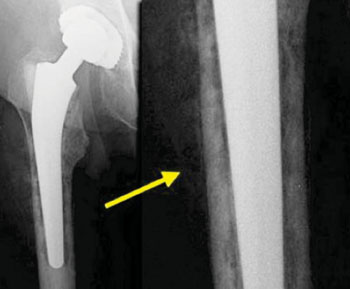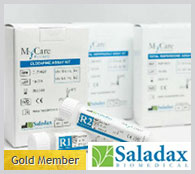Prosthetic Joint Infections Test Receives CE Marking
|
By LabMedica International staff writers Posted on 05 Feb 2015 |

Image: On the left are the typical radiographic findings of infection with irregular bone destruction and periosteal reaction. In many cases however the infection is really low grade and difficult to establish (Photo courtesy of Radiological Society of the Netherlands).
The first diagnostic test that can detect in patients' blood antibodies against several bacteria types frequently responsible for prosthetic infections, in particular Staphylococcus, the most often encountered type in such infections.
The new test has received Conformité Européenne (CE) marking, and provides qualitative information in a couple of hours for each targeted bacteria types, which enables caregivers, in association with the usual assessments, to accelerate and improve the care of patients who have prosthetic joint infections.
This BJI InoPlex test (Diaxonit; Paris France) requires 10 µl of serum taken by a simple blood draw and can be easily repeated. After adequate preparation, the test is carried out directly in the biology laboratory of the hospital with a standard Luminex instrument (Luminex; Austin, TX, USA). The test uses a combination of several recombinant protein antigens to test for anti-Staphylococcus immunoglobulin G (IgG for S. aureus and S. epidermidis). The BJI InoPlex kit contains various reagents necessary to perform the test, a 96-well filter plate, calibration CD-ROM containing specific calibration information for each batch and a user manual. The BJI InoPlex software is used to interpret the data and report a result per family of bacteria.
The performance of BJI InoPlex compared with microbiological results on intraoperative samples are respectively 82.2% for specificity and 75.9% for sensitivity, all types of targeted staphylococci included. Other bacteria targeted by BJI InoPlex are less frequent in the prevalence of prosthetic infections, and the incidence of proven intraoperative infections with these bacteria also ended up being limited in the study cohort. The high specificity of the test for two families of bacteria, Group B-Streptococcus and Propionibacterium acnes, preferentially orients towards the absence of an immune response against these types of bacteria, BJI InoPlex is being used in addition to other tests performed.
Related Links:
Diaxonit
Luminex
The new test has received Conformité Européenne (CE) marking, and provides qualitative information in a couple of hours for each targeted bacteria types, which enables caregivers, in association with the usual assessments, to accelerate and improve the care of patients who have prosthetic joint infections.
This BJI InoPlex test (Diaxonit; Paris France) requires 10 µl of serum taken by a simple blood draw and can be easily repeated. After adequate preparation, the test is carried out directly in the biology laboratory of the hospital with a standard Luminex instrument (Luminex; Austin, TX, USA). The test uses a combination of several recombinant protein antigens to test for anti-Staphylococcus immunoglobulin G (IgG for S. aureus and S. epidermidis). The BJI InoPlex kit contains various reagents necessary to perform the test, a 96-well filter plate, calibration CD-ROM containing specific calibration information for each batch and a user manual. The BJI InoPlex software is used to interpret the data and report a result per family of bacteria.
The performance of BJI InoPlex compared with microbiological results on intraoperative samples are respectively 82.2% for specificity and 75.9% for sensitivity, all types of targeted staphylococci included. Other bacteria targeted by BJI InoPlex are less frequent in the prevalence of prosthetic infections, and the incidence of proven intraoperative infections with these bacteria also ended up being limited in the study cohort. The high specificity of the test for two families of bacteria, Group B-Streptococcus and Propionibacterium acnes, preferentially orients towards the absence of an immune response against these types of bacteria, BJI InoPlex is being used in addition to other tests performed.
Related Links:
Diaxonit
Luminex
Latest Microbiology News
- High-Accuracy Bedside Test to Diagnose Periprosthetic Joint Infection in Five Minutes
- Innovative Diagnostic Approach for Bacterial Infections to Enable Faster and Effective Treatment
- Non-Invasive Stool Test to Diagnose Endometriosis and Help Reduce Disease Progression
- Automated Positive Blood Culture Sample Preparation Platform Designed to Fight Against Sepsis and AMR
- Revolutionary Molecular Culture ID Technology to Transform Bacterial Diagnostics
- New Digital PCR Assays Enable Accurate and Sensitive Detection of Critical Pathogens
- Rapid Diagnostic System to Deliver Same-Shift Antibiotic Susceptibility Test Results
- AST System Delivers Actionable Results for Gram-Negative Bacteria Directly from Positive Blood Cultures
- Ultra-Rapid Culture-Free Sepsis Test Reduces Testing Time from Days to Hours
- New Rapid Method for Determining Virus Infectivity Could Revolutionize Response to Future Pandemics
- Novel Molecular Test to Help Prevent and Control Multi Drug-Resistant Fungal Pathogen in Healthcare Settings
- Innovative C. Difficile Diagnostic Test Provides Both GDH and Toxin Results within 30 Minutes
- Rapid UTI Test Cuts Detection Time from 3 days to 45 Minutes
- POC STI Test Shortens Time from ED Arrival to Test Results
- Integrated Solution Ushers New Era of Automated Tuberculosis Testing
- Automated Sepsis Test System Enables Rapid Diagnosis for Patients with Severe Bloodstream Infections
Channels
Clinical Chemistry
view channel.jpg)
POC Saliva Testing Device Predicts Heart Failure in 15 Minutes
Heart failure is a serious condition where the heart muscle is unable to pump sufficient oxygen-rich blood throughout the body. It ranks as a major cause of death globally and is particularly fatal for... Read more
Screening Tool Detects Multiple Health Conditions from Single Blood Drop
Infrared spectroscopy, a method using infrared light to study the molecular composition of substances, has been a foundational tool in chemistry for decades, functioning similarly to a molecular fingerprinting... Read more
Integrated Chemistry and Immunoassay Analyzer with Extensive Assay Menu Offers Flexibility, Scalability and Data Commutability
As global healthcare systems increasingly shift towards networked laboratory operational models to enhance efficiency and patient access, there is a greater need for innovative solutions tailored to the... Read moreMolecular Diagnostics
view channel
Respiratory Panel to Help Clinicians Make Precise Treatment Decisions in Outpatient Settings
Respiratory tract infections are the primary reason for visits to emergency departments and subsequent hospitalizations. In the U.S., it is estimated that there are up to 41 million cases of influenza... Read more
Integrating Cardiovascular Risk Biomarkers Aids in Detection of ‘Inflammaging’
Cardiovascular diseases (CVD) continue to be the leading cause of death globally, responsible for nearly one-third of all fatalities worldwide. Traditionally, risk assessment for CVD has focused on well-established... Read more
Genetic Signature in Newborns Predicts Neonatal Sepsis Before Symptoms Appear
Neonatal sepsis, which occurs due to the body’s abnormal response to severe infection within the first 28 days of life, results in approximately 200,000 deaths globally each year. This condition affects around 1.... Read more.jpeg)
Integrating Multiple Protein Markers Predicts Health Outcomes in Chronic Kidney Disease Patients
Previous attempts to discover novel kidney biomarkers as risk factors for chronic kidney disease (CKD) progression have generally focused on evaluating proteins individually, which limits their prognostic... Read moreHematology
view channel
Next Gen CBC and Sepsis Diagnostic System Targets Faster, Earlier, Easier Results
Every hour is critical in protecting patients from infections, yet there are currently limited tools to assist in early diagnosis before patients reach a hospital. The complete blood count (CBC) is a common... Read more
Newly Discovered Blood Group System to Help Identify and Treat Rare Patients
The AnWj blood group antigen, a surface marker discovered in 1972, has remained a mystery regarding its genetic origin—until now. The most common cause of being AnWj-negative is linked to hematological... Read more
Blood Platelet Score Detects Previously Unmeasured Risk of Heart Attack and Stroke
Platelets, which are cell fragments circulating in the blood, play a critical role in clot formation to stop bleeding. However, in some individuals, platelets can become "hyperreactive," leading to excessive... Read moreImmunology
view channel
Computational Tool Predicts Immunotherapy Outcomes for Metastatic Breast Cancer Patients
Immunotherapy aims to enhance the body’s immune response to target cancer cells, but not all patients experience a positive reaction to such treatments. Identifying which patients will benefit from immunotherapy... Read more
Biomarker Could Predict Immunotherapy Response in Liver Cancer
Until recently, patients diagnosed with hepatocellular carcinoma had limited treatment options, with existing therapies extending life by only a few months. Immunotherapy has emerged as a new alternative... Read more
Epigenetic Test Could Determine Efficacy of New Immunotherapy Treatments Against Multiple Myeloma
Multiple myeloma is a blood cancer that primarily affects individuals over the age of sixty, and its occurrence rises as the population ages. In this disease, the bone marrow—the spongy tissue inside bones... Read morePathology
view channel
New Imaging Method Opens Door to Precision Diagnostics for Head and Neck Cancers
Head and neck cancers, while considered rare, represent a significant portion of cancer cases and have seen a notable increase over the past 30 years. These cancers encompass various malignant tumors that... Read more
Faster Measurement of Vibrational Fingerprint of Molecules to Advance Biomedical Diagnostics
Identifying different types of molecules and cells is a vital process in both basic and applied science. Raman spectroscopy serves as a widely utilized measurement technique for this purpose.... Read moreTechnology
view channel
New Noninvasive Methods Detect Lead Exposure Faster, Easier and More Accurately at POC
Exposure to lead can negatively affect health in multiple ways, leading to damage in the brain and central nervous system, delays in development and growth, learning and behavioral issues, problems with... Read more
Noninvasive Test Detects Malaria Without Blood Sample
Malaria remains a significant global health issue, with approximately 250 million cases and over 600,000 deaths reported annually. Nearly half of the world's population is at risk for malaria infection,... Read moreIndustry
view channel
Beckman Coulter Partners with BioPorto for Global Distribution of Acute Kidney Injury NGAL Tests
Acute kidney injury (AKI) is a sudden episode of kidney failure or damage that can occur within a few hours or days. This condition leads to the accumulation of waste products in the blood and disrupts... Read more_1.jpg)
CACLP 2025 New Date and Venue Announced
The 22nd China International In Vitro Diagnostic Expo, organized by the China Association of Clinical Laboratory Practice Expo (CACLP, Shanghai, China), is set to take place from March 21 to 24, 2025,... Read more
Roche to Develop New Diagnostic Technologies for Traumatic Brain Injuries
Traumatic brain injuries (TBI) represent a significant global health issue, affecting approximately 69 million people each year. TBI occurs when an external force disrupts normal brain function, with severity... Read more
















